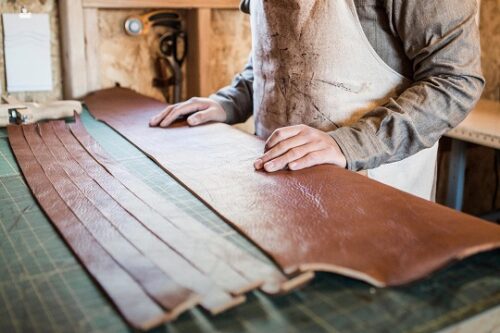8 June 2022
People who buy leather products want to feel assured that their choice of materials and products is the right one; sustainable for people and planet alike. Increasing social consciousness and environmental activism are placing the ancient art of leather making under scrutiny. Are the animals from which the hide is used treated well? Are the people who produce the leather treated fairly? And are the tanners and manufacturers doing everything with the environment in mind? Report by One 4 Leather.

The European leather industry is actually at the forefront of the conversation and innovation towards lower impact and circular practices. It’s closely involved in advancing legislation, safe and healthy practices, and strives for traceability and guarantees of high standards in animal welfare.
Leather making: the inception of waste management
Leather is considered a luxury material, yet not a single animal is raised for its hide. There’s no economic sense to it as all leather is produced from meat industry by-products. Historically, it’s always been this way and leather precedes the concept of recycling (and to this day leather is recycled itself). The hides are there, easily available. Even if everyone would stop eating meat today, the global pile of hides still available would constitute an overwhelming amount of waste. If not for leather making, it would all go into landfills or get incinerated and be replaced with plastics.
To be clear, according to the FAO (2016), we are talking about 6,5 billion kilograms of bovine hides. And we can add about 0,8 billion kilograms of sheep and goatskins to this pile. ‘A lot’ would be an understatement.
Unlikely champions of animal welfare
Leather tanners and artisans are highly invested in all aspects of sustainability, including the way animals are treated, as this directly impacts the quality of the leather they receive. This is especially true of the automotive industry. Not only must the hides be large and thick for luxurious car upholstery, but they also need to be free of blemishes that come from bad conditions or treatment. Quality-conscious automotive tanners, for that very reason, hold high standards for ethical leather sourcing and have an economic interest in animal well-being.
A 2011 Cotance (Confederation of National Associations of Tanners and Dressers of the European Community) report on the transparency and traceability of leather hides revealed that customer queries and requests for reassurance spiked whenever the media published shocking stories. European tanners understand the public’s ethical concerns about animal welfare. They may not directly be involved in the treatment of animals, but feel the ethical obligation to push for better treatment as awareness grows with every scandal. In that sense, the push for even higher standards and scrutiny is a good thing, as it mobilizes the entire supply chain. ILM stated in 2019 that, for leather animal welfare must be at the heart of the narrative, and transparency and traceability are key to realize this. For the food industry itself, however, it is an uphill struggle as low price competition and reduced margins make implementing changes a challenge.
Demanding change from inside the supply chain
Change is also coming from inside the supply chain, where automotive leather producers lead the charge. These large, often multi-national organizations are governed by institutional standards such as OHSAS 18001 and ISO 14001, regardless of whether they are in Europe or not. Their high standards affect the meat producers that supply the automotive leather makers, as well as the markets that are served by their final, high-quality product.
In Europe, tanneries can also apply for certification through bodies such as the Institute of Quality Certification for the Leather Sector (ICEC). They have an online database of tanneries that adhere to standards, based on environmental, ethical, social, product and economic sustainability. ICEC reports significant improvements in their 2018 sustainability report on all levels.
Raising the bar on health and safety
There are several other institutes setting standards and ISO norms that leather manufacturers comply with on quality management of product and production. This is important, because health and safety in leather production is another topic often misrepresented in the media. While there are still abysmal industry standards in some developing countries (leather manufacturing is no exception to the norm there), the European leather industry puts safety and health standards as a top priority. Cotance has been working tirelessly with partners like industriAll and affiliates to create uniform standards and implement due diligence (2018). The report also acknowledges the fact that no industry can do it all by itself. Change is a supply chain-wide effort.
Traceability from field to seat
Some of the world’s leading leather processing companies are working on systems that enable full traceability from farm to finished product. The challenge is often in the overview of the supply chain and only the biggest companies, with full control, are able to realize that for part of the process. Transparency and cooperation are needed to make this a reality. Consumers and brands want to be able to determine what farm the animal was raised on, the slaughter date and the chemicals used in the tanning process. While not yet available, this is the ambition for future development, where accountability will inform every aspect of the leather supply chain.
There is still a lot to be done in countering the damage done to the leather industry, as it has become an unjustified target for many critics. Yet, automotive leather producers believe that the widespread awareness and attention for better, more sustainable, and safer practices will, in the end, benefit leather production as well as life on our planet.

使用條款 | 隱私政策 | APLF 可持續發展